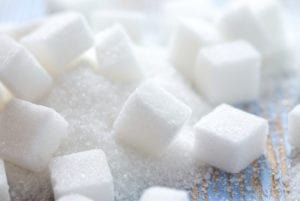Written by Jessica Patella, ND. This study shows that reducing added sugar intake by 2.3 teaspoons, or about 1/4th of a can of soda, could significantly reduce both systolic and diastolic blood pressure in women.
 According to the American Heart Association more than 100 million Americans have high blood pressure 1. High blood pressure is often referred to as the silent killer, because there are few symptoms, yet it can result in heart disease, stroke, heart failure, kidney disease and vision loss 2,3. Blood pressure tends to increase as a person ages and new blood pressure guidelines put even more people in the category as hypertensive (having high blood pressure) 2. The new guidelines classify hypertension as a systolic blood pressure of 130mmHg or higher and a diastolic blood pressure of 80mmHg or higher (previously was 140/90 mmHg) 2,4. The reason for this change was due to lower risk of cardiovascular disease with lower blood pressure levels 2. Research has shown small changes in diet can have a significant effect on blood pressure and cardiovascular health, for this reason this study was conducted to evaluate dietary factors and blood pressure in older adults 2.
According to the American Heart Association more than 100 million Americans have high blood pressure 1. High blood pressure is often referred to as the silent killer, because there are few symptoms, yet it can result in heart disease, stroke, heart failure, kidney disease and vision loss 2,3. Blood pressure tends to increase as a person ages and new blood pressure guidelines put even more people in the category as hypertensive (having high blood pressure) 2. The new guidelines classify hypertension as a systolic blood pressure of 130mmHg or higher and a diastolic blood pressure of 80mmHg or higher (previously was 140/90 mmHg) 2,4. The reason for this change was due to lower risk of cardiovascular disease with lower blood pressure levels 2. Research has shown small changes in diet can have a significant effect on blood pressure and cardiovascular health, for this reason this study was conducted to evaluate dietary factors and blood pressure in older adults 2.
The research included 127 participants (57 males, 70 females). Participants sat in a quiet room for 5-minutes before blood pressure was measured. Blood pressure results were categorized as follows:
- normal: below 120/80 mmHg
- elevated: 120-129/80 mmHg
- high: above 130/80 mmHg
The participants had to fill out a food frequency questionnaire to assess average daily intake of food, beverages and supplements (2005 Nutrition Question Food Frequency Questionnaire) 2.
The average age was 70.8 +/- 4.1 years for males and 70.6 +/- 4.0 years for females. The average BMI for all participants was 29.1 +/- 5.1 kg/m2.
The following results were observed:
Males had significantly higher systolic blood pressure than females (143.3 +/- 17.1 mmHg males, 130.6 +/- 23.2 mmHg females; p=0.001)
- Males had significantly higher mean arterial pressure than females (100.3 +/- 12.4 males, 94.6 +/- 16.2 mmHg females; p=0.029)
- Males consumed more juice (p=0.041) and more alcohol (p=0.009) than females
- In both sexes whole fruit consumption was associated with diastolic blood pressure (95%CI= -7.7, -0.2; p=0.04).
- This equated to a predicted decrease of 2.8 mmHg in diastolic blood pressure for every 0.71 cup increase in whole fruit
- An association between intake of added sugars and an increase in both systolic (95%CI= 1.7, 5.6; p<0.001) and diastolic (95% CI=0.4, 2.8; p=0.011) blood pressure in females.
- This equated to a predicted decrease of 8.4 mmHg systolic and 3.7 mmHg diastolic blood pressure with every 2.3 teaspoon decrease in added sugar intake.
In this study participants consumed about 10% or more of their daily calories from added sugar, with an average intake of 9.1 teaspoons of sugar 2. This is above recommendations from the American Heart Association which recommends about 6 teaspoons for women and 9 teaspoons for men per day 5. The DASH diet for heart health has even stricter recommendations of 9 teaspoons or less per week 2. To give an equivalent, one soda has approximately 9 teaspoons of sugar 2.
The researchers analyzed this data and suggested that reducing added sugar intake by 2.3 teaspoons, or about 1/4th of a can of soda, could significantly reduce both systolic and diastolic blood pressure in women. This change in sugar intake could potentially reduce the percentage of women participants in the study with hypertension from 47.1% to 21.4% 2.
In conclusion, participants in the study consumed on average more added sugar than recommended. The findings also suggest reducing added sugar consumption and increasing whole fruit consumption could reduce blood pressure in women. This was a pilot study and clinical trial studies are needed to confirm the findings.
Source: Mansoori, Safiyah, Nicole Kushner, Richard R. Suminski, William B. Farquhar, and Sheau C. Chai. “Added Sugar Intake is Associated with Blood Pressure in Older Females.” Nutrients 11, no. 9 (2019): 2060.
© 2019 by the authors. Licensee MDPI, Basel, Switzerland. This article is an open access article distributed under the terms and conditions of the Creative Commons Attribution (CC BY) license (http://creativecommons.org/licenses/by/4.0/)
Click here to read the full text study.
Posted October 14, 2019.
References:
- American Heart Association. More than 100 million Americans have high blood pressure, AHA says. 2019; https://www.heart.org/en/news/2018/05/01/more-than-100-million-americans-have-high-blood-pressure-aha-says. Accessed September 25, 2019.
- Mansoori S, Kushner N, Suminski RR, Farquhar WB, Chai SC. Added Sugar Intake is Associated with Blood Pressure in Older Females. Nutrients. 2019;11(9):2060.
- CDC. High Blood Pressure. 2019; https://www.cdc.gov/bloodpressure/index.htm. Accessed September 27, 2019.
- Benjamin EJ, Virani SS, Callaway CW, et al. Heart disease and stroke statistics-2018 update: a report from the American Heart Association. Circulation. 2018;137(12):e67.
- American Heart Association. Added Sugars. 2019; https://www.heart.org/en/healthy-living/healthy-eating/eat-smart/sugar/added-sugars. Accessed September 27, 2019.

